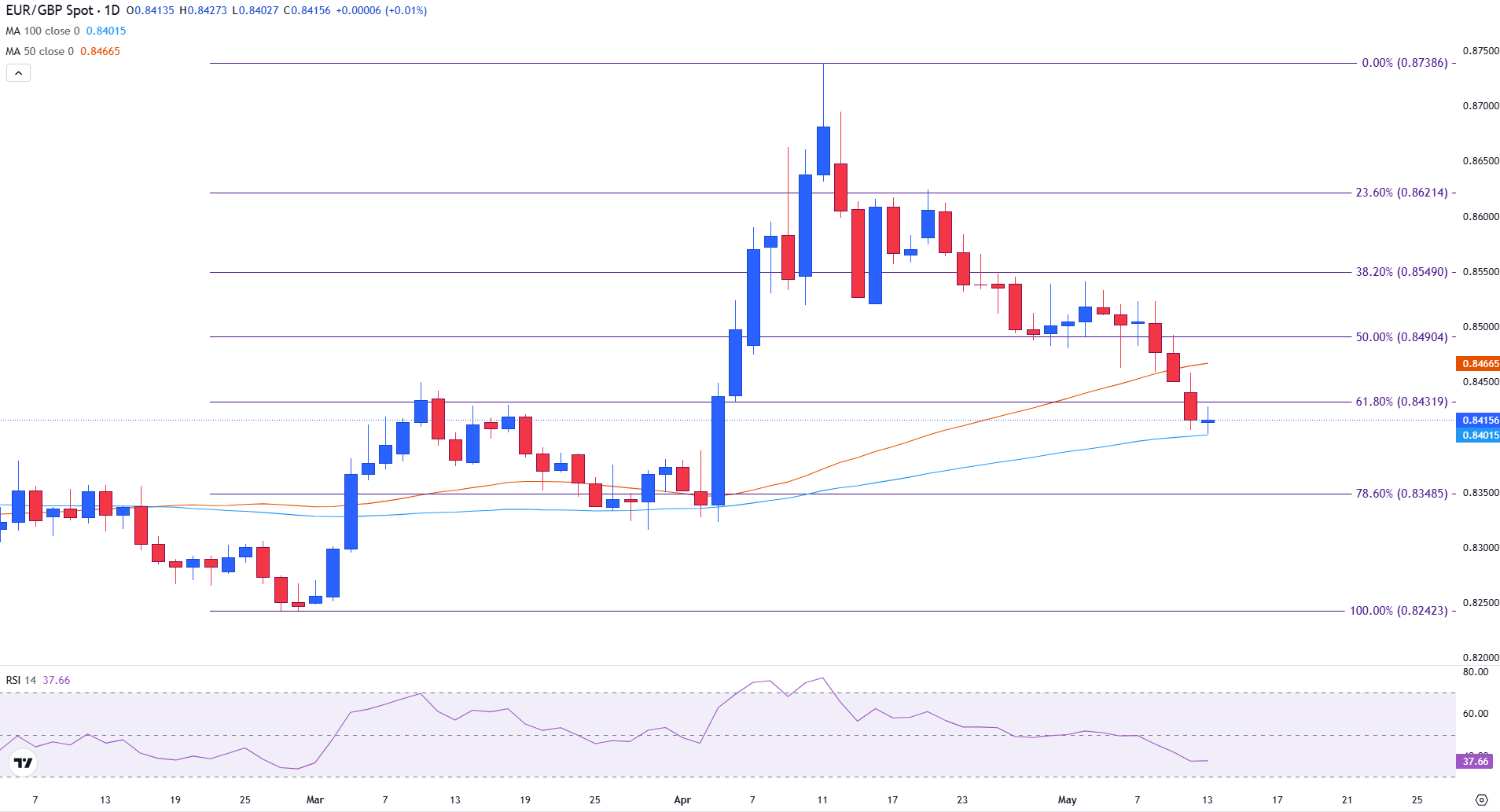- Diverging policy outlooks from the European Central Bank and the Bank of England weigh on the Euro.
- UK labour data shows mixed signals, but strong wage growth keeps pressure on the BoE to stay cautious on rate cuts.
- EUR/GBP tests key technical support around the 100-day Moving Average.
The Euro (EUR) remains under pressure against the British Pound (GBP) on Tuesday as diverging monetary policy expectations between the European Central Bank (ECB) and the Bank of England (BoE) continue to drive sentiment.
At the time of writing, EUR/GBP trades near 0.8419, slightly below a critical support zone but showing signs of stabilization ahead of high-impact events.
On Tuesday, the German ZEW Economic Sentiment Index offered a modestly positive surprise in forward-looking expectations but was offset by a disappointing current conditions component. Market participants largely ignored the data, instead focusing on ECB signals that continue to point toward interest rate cuts as early as June, reinforcing the bearish bias for the Euro. In contrast, the BoE has maintained a cautious stance, waiting for more sustained disinflation signals before committing to a dovish pivot.
UK labour data mixed, but wage growth complicates BoE outlook
Economic data released Tuesday by the United Kingdom’s Office for National Statistics (ONS) offered a nuanced view of domestic labour conditions. The ILO Unemployment Rate, a three-month moving average of joblessness calculated by the International Labour Organization, rose slightly to 4.5%, up from 4.4% and in line with forecasts.
Meanwhile, the Claimant Count, which measures the number of people applying for unemployment-related benefits, rose by 5,200 in April. Though an increase, this figure was far better than the expected 22,300, suggesting some resilience.
However, Employment Change, a metric tracking the net number of jobs added, slowed to 112,000 in March from 206,000 in February, pointing to reduced hiring momentum.
The most notable takeaway came from the Average Earnings Index, a gauge of wage inflation. Wages excluding bonuses rose 5.6% YoY, just under the forecast of 5.7%. Earnings, including bonuses, rose 5.5%, beating expectations of 5.2%. These elevated pay figures indicate persistent inflationary pressure in the labour market, complicating the BoE’s ability to ease policy without undermining its inflation target.
ECB easing bias under scrutiny ahead of German inflation data
The Euro’s recent underperformance also reflects market conviction that the ECB will act sooner than its peers in delivering policy easing. Policymakers have increasingly signaled their comfort with cutting interest rates as inflation trends lower across the euro area. Focus now shifts to Wednesday’s German Harmonized Index of Consumer Prices (HICP) for April, a Eurozone-aligned inflation measure, which is expected to remain steady at 2.2% YoY.
A downside surprise could cement expectations of a June rate cut, likely deepening the EUR/GBP downtrend.
EUR/GBP clings to support as bears eye deeper retracement
From a technical perspective, EUR/GBP is testing support near the 61.8% Fibonacci retracement level of the March–April rally, a zone commonly viewed by traders as a critical inflection point. This level, located at 0.8432, often signals a potential reversal if held, or a continuation of the trend if broken decisively.
The pair is currently trading just beneath this Fibonacci level at 0.8419, while still hovering above the 100-day Simple Moving Average (SMA) at 0.8402, which acts as dynamic support.
The 50-day SMA, now at 0.8467, serves as the first layer of resistance, aligning closely with the 50% retracement level at 0.8490. A daily close below both the 61.8% retracement and the 100-day SMA would confirm a bearish continuation, opening the door toward the 78.6% retracement at 0.8349, followed by full retracement support at 0.8242.
The Relative Strength Index (RSI) — a momentum oscillator measuring overbought or oversold conditions — is currently below 38, moderately above the oversold threshold of 30. This suggests downside momentum may be stretched, though not necessarily exhausted.
EUR/GBP daily chart

As long as EUR/GBP remains below the 50-day SMA and fails to reclaim key Fibonacci levels, technical bias favors the downside. Traders will be looking for cues from BoE and ECB speakers this week, alongside the German inflation release, for the next directional move. A confirmed break below 0.8400 would further embolden bears, while a recovery above 0.8490 could signal a near-term reversal.
Central banks FAQs
Central Banks have a key mandate which is making sure that there is price stability in a country or region. Economies are constantly facing inflation or deflation when prices for certain goods and services are fluctuating. Constant rising prices for the same goods means inflation, constant lowered prices for the same goods means deflation. It is the task of the central bank to keep the demand in line by tweaking its policy rate. For the biggest central banks like the US Federal Reserve (Fed), the European Central Bank (ECB) or the Bank of England (BoE), the mandate is to keep inflation close to 2%.
A central bank has one important tool at its disposal to get inflation higher or lower, and that is by tweaking its benchmark policy rate, commonly known as interest rate. On pre-communicated moments, the central bank will issue a statement with its policy rate and provide additional reasoning on why it is either remaining or changing (cutting or hiking) it. Local banks will adjust their savings and lending rates accordingly, which in turn will make it either harder or easier for people to earn on their savings or for companies to take out loans and make investments in their businesses. When the central bank hikes interest rates substantially, this is called monetary tightening. When it is cutting its benchmark rate, it is called monetary easing.
A central bank is often politically independent. Members of the central bank policy board are passing through a series of panels and hearings before being appointed to a policy board seat. Each member in that board often has a certain conviction on how the central bank should control inflation and the subsequent monetary policy. Members that want a very loose monetary policy, with low rates and cheap lending, to boost the economy substantially while being content to see inflation slightly above 2%, are called ‘doves’. Members that rather want to see higher rates to reward savings and want to keep a lit on inflation at all time are called ‘hawks’ and will not rest until inflation is at or just below 2%.
Normally, there is a chairman or president who leads each meeting, needs to create a consensus between the hawks or doves and has his or her final say when it would come down to a vote split to avoid a 50-50 tie on whether the current policy should be adjusted. The chairman will deliver speeches which often can be followed live, where the current monetary stance and outlook is being communicated. A central bank will try to push forward its monetary policy without triggering violent swings in rates, equities, or its currency. All members of the central bank will channel their stance toward the markets in advance of a policy meeting event. A few days before a policy meeting takes place until the new policy has been communicated, members are forbidden to talk publicly. This is called the blackout period.

